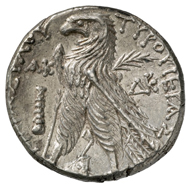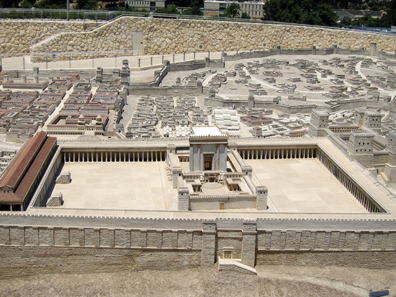with the kind permission of the MoneyMuseum, Zurich.
Why is it that for centuries – or rather thousands of years – the head has served as the motif for the side of a coin? And why has this changed in the last 200 years? Ursula Kampmann poses these questions in her book ‘MenschenGesichter,’ from which the texts for our new series are taken.
Tyre (Phoenicia). Tetradrachm, 106-105 B. C. Head of Melkart with laurel wreath r. Rev. eagle standing l. on prow, palm branch over the shoulder. © MoneyMuseum.
Then one of the Twelve, the one called Judas Iscariot, went to the chief priests and asked: ‘What are you willing to give me if I deliver him over to you?’ So they counted out for him thirty pieces of silver. From then on Judas watched for an opportunity to hand him over. (Mt. 26: 14–16)
Of course, we can’t say for sure what the 30 coins Judas received for handing over Jesus Christ exactly looked like but is it highly likely that they came from Tyre; after all, coins like these were used for centuries to pay the Jewish temple tax.
Melkart, who is depicted on our coin, was the most significant deity of the Phoenician city of Tyre. He was given an important temple there and received from his worshippers all those honors that the Jewish people considered idolatry. Originally, Melkart was a sun god who watched over the underworld and fertility simultaneously. The Greeks related Melkart to Zeus and, even more so, to Heracles. In any case, Melkart was a ‘Baal’ – you see, the Phoenicians used to bestow that name, which technically meant nothing else than ‘lord’, upon all of their deities. And, as it is told in the Book of Kings, the tale of Jezebel and Elias to be specific, the Jews had distinctly negative experiences with Baal.
Model of the temple of Jerusalem. The Israel Museum, Jerusalem. Photograph: UK.
The ones responsible at the temple of Jerusalem, however, accepted nothing else than Tyrian coins for paying the temple tax and they did so for a very simple reason: the silver fineness of these pieces virtually didn’t vary. Although they had been produced for quite a long time, their value remained constant and hence was easy to calculate. Thus, every Jew that wanted to pay the temple tax of one Tyrian didrachm was forced to change his money in Tyrian currency at the temple’s courtyard – that procedure infuriated a man called Jesus so much that he attacked the ubiquitous moneychangers.
Temple front with thora niche. The Israel Museum, Jerusalem. Photograph: UK.
When the city of Tyre stopped issuing coins, the temple’s financial administration lost its bearings. Herod the Great, who was later to be ‘credited’ with the Massacre of the Innocents at Bethlehem, obtained from Rome the right for the Jewish authorities to produce their own shekels after Tyrian models. As a matter of fact, until the beginning of the First Jewish-Roman War, i.e. until A. D. 66, coins were struck in the Promised Land of the people of Israel that depicted the god Baal.
You can find intriguing articles on the temples tax as well as the Tyrian shekels written by expert David Hendin here and here.
Present-day Jerusalem is a stop of the numismatic diary from June 2012.
Part 1
Part 2
All sections of the series can be found here.
The book ‘MenschenGesichter’ is available in printed form from the Conzett Verlag website where you can find it as an ebook too. It soon will be translated to English.









